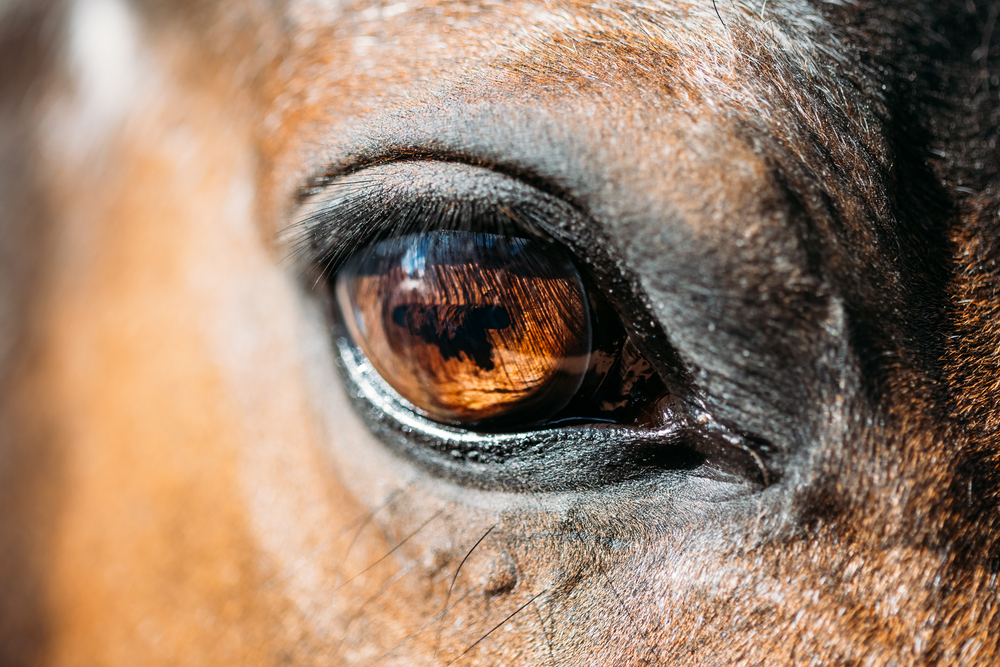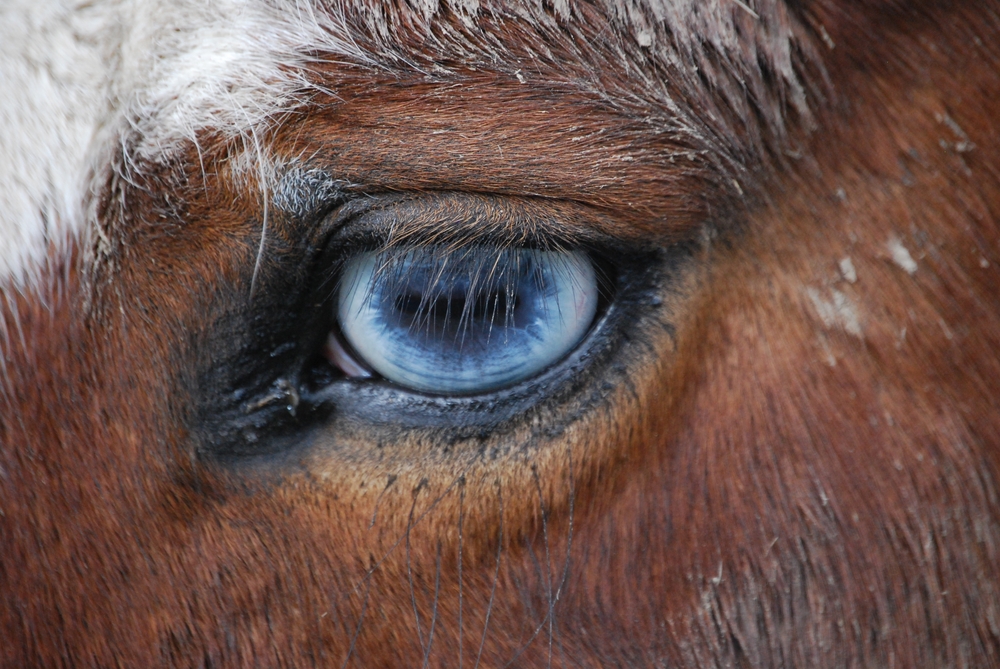- Your source for stall mats, rubber arena footing, arena harrows and arena dust control.

Horses are known for their dark soulful eyes, eyes which have captivated thousands for their liquid gentleness. Many people believe that the signature dark color of horse eyes is the only eye color found in horses. However, humans do not all have the same eye color, and neither do horses.
Like humans, horses have different eye colors. Horses and humans can have black, brown, blue, green, and hazel eyes. Red, grey and lavender eyes do not occur in horses, while tiger eyes are not found in humans. The rarest eye color found in both species is green, while the most common is brown.
Humans are programmed to notice and be attracted to novel or unique things. The thought of a blue- or green-eyed horse is an intriguing concept that has many people asking: Do horses have different eye colors like us?
What Eye Colours Do Horses And Humans Share?
Like humans, horses, as a species, feature a wide range of skin, hair, and eye colors. Although belonging to disparate species, horses and humans show similarities in their eye colors.
The different eye colors found within both species include:
- Black
- Brown
- Hazel
- Blue
- Green
What Creates Eye Color In Horses And Humans?
Three components of the external eye structure give the eye its distinctive coloration, the white sclera, black pupil, and colorful iris.
The sclera and pupil in horse and human eyes are almost always exclusively white and black. Thus, when most people refer to eye color, they are talking about the variable colors found in the iris of horse and human eyes.
Both horse and human eye colors are created by the expression of two different melanin pigments:
- Eumelanin
- Phaeomelanin
Eumelanin is a dark-colored pigment maximally expressed in black and rich chocolate brown eyes. By contrast, phaeomelanin is a red-yellow pigment found in hazel, amber, and green eyes.
Horse and human eye color exists on a continuum and not discrete categories, i.e., blue-, grey-, and black-colored eyes are on the same eumelanin-controlled spectrum.
What Is The Most Common Eye Color In Horses And Humans?
The wild-type variant for horses and humans is dark black-brown eyes, and thus the most common eye color in both species is a deep chocolate brown color.
It’s estimated that 70% to 80% of the world’s population has brown eyes, with dark-skinned people having a higher percentage of brown or black eyes. Although the exact number of horses with brown eyes is unknown, most scientists agree that the overwhelming majority of horses have brown eyes.
In people and horses with brown eyes, melanocytes within the iris produce large quantities of eumelanin’s black-brown pigment. The heavy concentration of eumelanin in the iris of brown and black eyes is often linked to darker skin and hair tones.
Do Horses Have Blue Eyes Like Humans?
Initially, everyone had dark-colored eyes; however, a mutation occurring approximately 6000 to 10 000 years ago introduced blue eyes into the human population.
Although blue is the second most common eye color, it is a distant second to the more common brown eyes. Approximately 8% to 10% of the world’s population has blue eyes.
The prevalence of horses with blue eyes is unknown. However, blue-eyed horses are typically the result of a modifying gene that causes hypopigmentation in the eyes and coat.
Broken coat patterns (i.e., horses with a two-toned coat) have been associated with blue eyes in horses. Horses with broken coat patterns are more likely to have blue eyes if:
- The white portions of the coat surround the eye
- The pattern is maximally expressed
Additional coat colors that have been linked with blue-eyed horses are genetic mutations causing color dilutions. Horses who are homozygous for the cream gene (i.e., smoky cream, cremello, and perlino) have a higher incidence of blue eyes than horses without a cream gene.
Do Blue-Eyed Horses And Humans Have Blue Pigment?
Many people mistakenly assume that blue eyes are due to blue pigment in the iris. Blue eyes are said to be a structural color because the color is not derived from the pigment coloration but rather from the physics of light.
People and horses with blue eyes have little to no eumelanin or collagen deposits in the stroma of the iris. When the light hits the iris instead of being absorbed, the light is reflected. The scattered light rays produced a blue color due to the Tyndall effect.
Why Do Some Humans And Horses Have “Fake” Blue Eyes?
Occasionally, a horse or human may appear to have blue eyes due to injury or disease. Injuries can cause milky-blue scaring in the iris, similar to the opaque blue eye color found in people with cataracts.
While these clouded eyes may appear blue, their blue appearance does not reflect the horse’s or human’s natural eye color.
Most people can easily distinguish between a true blue eye versus an acquired blue eye, i.e., blue due to injury or disease. Natural blue eye color is a clear blue that may or may not have a darker blue or gold ring surrounding the eye. In comparison, an acquired blue eye will be an opaque cloudy blue.

Are There Eye Colors Humans Have That Horses Don’t?
The rarest eye colors found in humans are red, lavender, and grey. These eye colors are caused by extreme hypopigmentation of the iris and may be due to hypopigmentation disorders such as albinism.
True albinism does not exist in horses, and thus there have been no documented cases of horses with lavender, red or grey eyes.
Are There Eye Colors Horses Have That Humans Don’t?
Tiger eye is an exceptionally rare eye color mutation found in horses and not in humans. Two tiger eye recessive gene mutations (i.e., TE1 and TE2) have been identified in the Puerto Rican Paso Fino horses.
A horse with TE1/TE1 or TE1/TE2 genotype will have topaz-colored eyes, i.e., yellow, orange, or burnt amber eyes. If paired with a cream gene, a horse with a TE2/TE2 genotype will have blue eyes. Heterozygous horses are carriers and have the expected dark brown eyes.
Unlike green- or blue-eyed horses, the tiger eye mutation is independent of the horse’s coat color.
What Is The Rarest Eye Color In Horses And Humans?
Green-colored eyes are the rarest eye color found in both horses and humans. Green eyes are due to eumelanin and phaeomelanin mixtures.
True green eyes predominantly have phaeomelanin pigmentation, while green-blue eyes have more eumelanin than phaeomelanin. Hazel-green eyes have an equal mix of both phaeomelanin and eumelanin.
Green-eyed horses are scarce and limited to horses with homozygous cream, champagne, or pearl genotypes. Hazel-green and green-blue eyes are more common in horses than true green eyes. Many horses with green eyes have a darker gold ring surrounding the iris.
Green-eyed humans are slightly more common than green-eyed horses and account for 1% to 2% of the global population. Almost all green-eyed people are of European descent.
Conclusion
Horses and humans both show a broad spectrum of eye colors.
Brown is the wild type allele for horses and humans, and thus the most common eye color shared by both species; green is the rarest.
Lavender, red and grey eyes are only found amongst the human population, i.e., there have been no documented cases of purple, red, or silver-eyed horses. Although similar to the human eye-color amber, tiger eye is not a true amber and is unique to Paso Fino horses.
References
- https://medlineplus.gov/genetics/understanding/traits/eyecolor/#:~:text=Eye%20color%20is%20directly%20related,much%20less%20of%20this%20pigment

- https://www.worldatlas.com/articles/which-eye-color-is-the-most-common-in-the-world.html

- https://www.nature.com/articles/jhg2010126#:~:text=When%20there%20is%20too%20little,blue%2C%20producing%20a%20violet%20color.&text=One%20leads%20to%20eumelanin%2C%20a,pigment%20(red%2Dyellow)

- https://www.livescience.com/9578-common-ancestor-blue-eyes.html

- https://colorgenetics.info/equine/eye-color-horses

- https://www.sciencealert.com/science-how-blue-eyes-get-their-colour

- https://academic.oup.com/g3journal/article/7/8/2799/6031496?login=true

- https://pubmed.ncbi.nlm.nih.gov/9778410/


